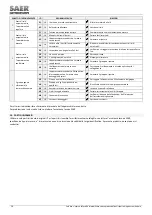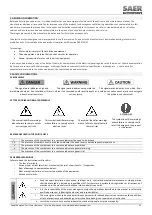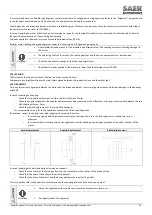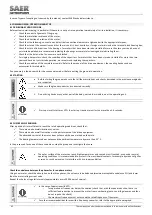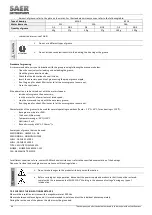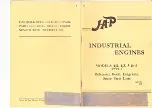
Keep the manual for future reference – For more informations visit www.saerelettropompe.com
41
It is recommended to use flexible couplings that can tolerate minimal misalignments during operation. Refer to the "Alignment" paragraph and
to the technical documentation of the device and the equipment conducted for more details.
Coupling devices and driven equipment must have a suitable degree of balance. In some cases it may be necessary to perform a balancing of
the complete machine (refer to ISO 10816).
In case of coupling by means of belts and pulleys (version on request), the tension of the belts must not exceed the allowed values. Refer to
the specific documentation of the coupling devices used.
The loads applied to the motor must not exceed the allowed values (TAB.IX).
Perform motor leveling and group alignment as per the "Leveling" and "Alignment" paragraphs.
ATTENTION!
·
Use suitable tools and means for the assembly and disassembly of the coupling elements, avoiding damage to
the motor.
·
The operating limits of the motor, the coupling devices and the driven equipment must be respected.
ü
Check the cleanliness and regularity of the coupling surfaces.
ü
Check that the loads applied to the motor are lower than the allowed values (TAB.IX)
5.15 LEVELING
The flatness of the support surface of the feet must not exceed ± 0,1mm.
Compensate any slight deviations with metal shims placed between the support surface and the motor feet.
5.16 ALIGNMENT
Carry out the correct alignment between the motor and the driven equipment. Incorrect alignment causes vibrations, damage to the bearings
and shaft.
In case of coupling by coupling:
-
Check that the axial displacement is within the limits (S1max / S1min).
-
Check the angular alignment: the angular displacement can be measured as the difference in the gap measurement between the two
half-couplings (Smax - Smin).
-
Check the radial displacement of the two half couplings (x).
For acceptability limits refer to the specific documentation of the coupling device.
If necessary, correct the angular and radial alignment by moving the motor:
o
for motors equipped with adjustment screws in the feet (optional), turn the leveling screws to obtain the correct
alignment.
o
for motors without leveling screws, the alignment must be obtained by placing appropriate shims under the feet of the
motor.
Axial displacement
Angular displacement
Radial displacement
In case of coupling with belts and pulleys (version on request):
-
Check that the center of the driving pulley is on the same plane as the center of the driven pulley.
-
Check that the axes of the pulleys are perfectly parallel.
-
Check that the axes of the motor and the driven equipment are perfectly parallel.
For more details, refer to the specific documentation of the coupling device and the driven equipment.
ATTENTION!
·
Check the alignment with suitable tools (precision comparators, lasers, etc ...)
ü
Periodically check the alignment.




